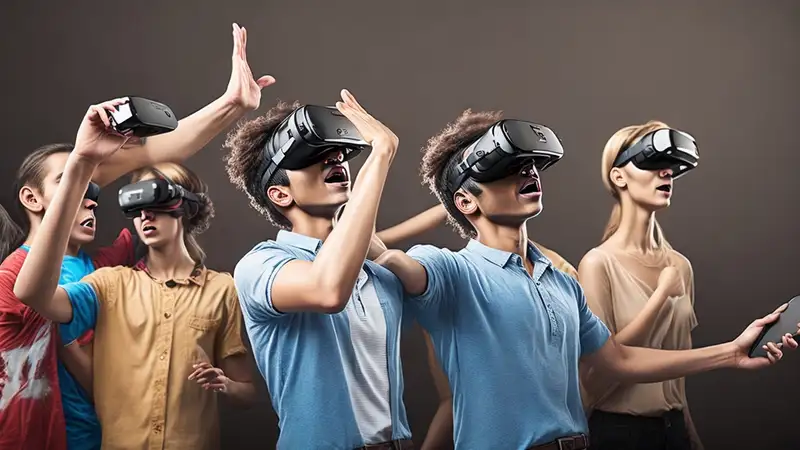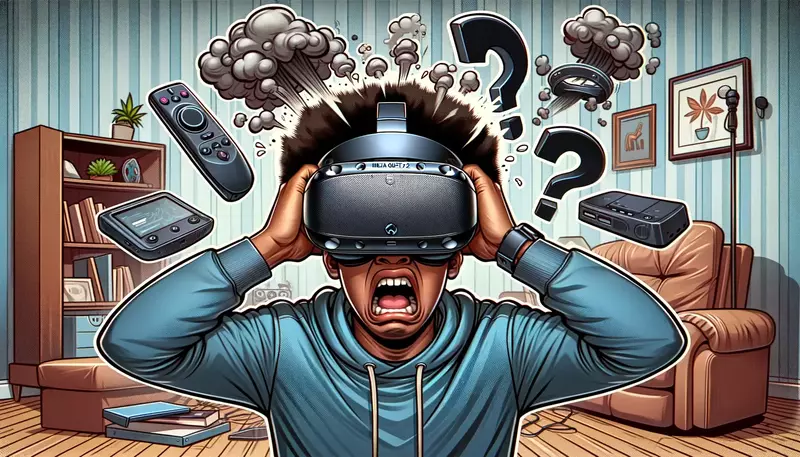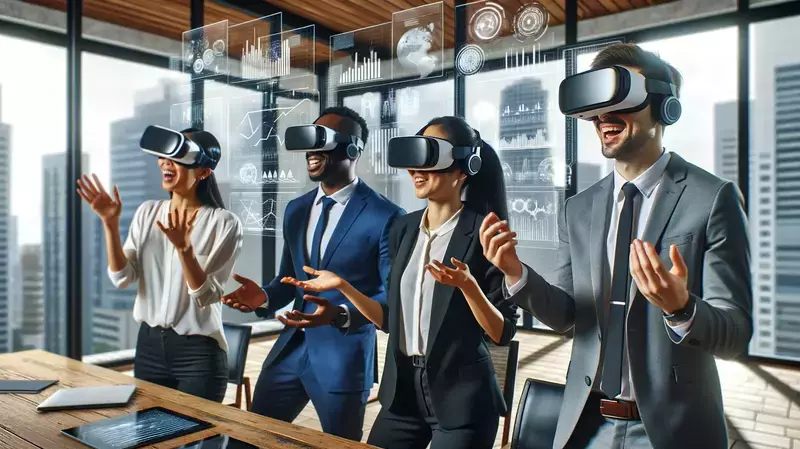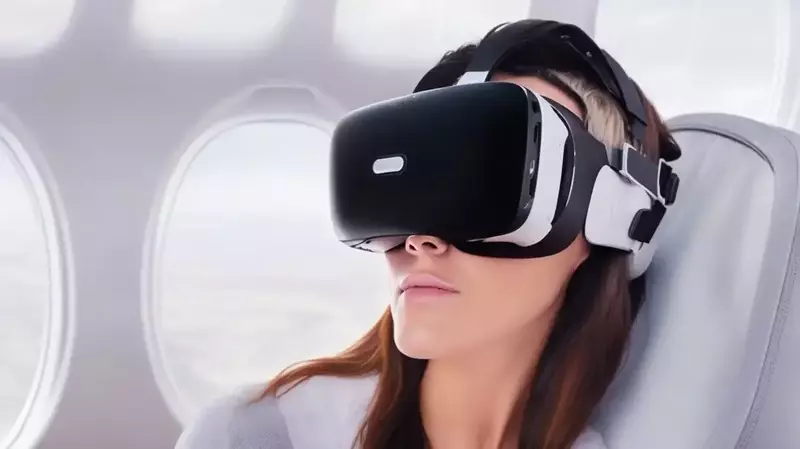This site contains affiliate links to products, and we may receive a commission for purchases made through these links.
Can virtual reality be used to investigate persecutory ideation? This intriguing question lies at the intersection of psychology and technology as researchers continue to explore innovative ways to study complex mental phenomena.
This post will look into the utilization of virtual reality (VR) in comprehending and dealing with persecutory ideation.

Key Takeaway!
Virtual reality technology has emerged as a promising tool for investigating persecutory ideation and understanding its underlying mechanisms. VR allows researchers to study how people perceive threats and respond to them under different circumstances, providing valuable insights into cognitive functioning without the limitations of traditional paper-and-pencil tests. As our understanding of this phenomenon grows through such studies, we may be better equipped to develop effective treatments for those affected by it.
Overview of Persecutory Ideation and Virtual Reality
Persecutory ideation is a psychiatric symptom characterized by the belief that one is being targeted, harassed, or persecuted by others. This can manifest in various ways, such as feeling watched, followed, or threatened.
It often occurs in individuals with mental health disorders like schizophrenia and paranoia but may also be present in other conditions.
Virtual reality (VR) technology has emerged as a promising tool for investigating persecutory ideation and understanding its underlying mechanisms.
By immersing users in realistic yet controlled environments, VR allows researchers to study how people perceive threats and respond to them under different circumstances.
The Role of Virtual Reality in Psychiatry
In recent years, psychiatry has increasingly utilized virtual reality for diagnostic and therapeutic interventions. For instance:
- Exposure therapy: VR-based exposure therapy helps patients confront their fears gradually while remaining safe within a simulated environment.
- Cognitive assessment: Virtual tasks can provide valuable insights into cognitive functioning without the limitations of traditional paper-and-pencil tests.
- Social skills training: Simulated social interactions enable individuals with an autism spectrum disorder or social anxiety to practice communication skills without fear of judgment from their real-life counterparts.
Investigating Persecutory Ideation Through VR Experiments
To investigate persecutory ideation using virtual reality technology, participants are placed into immersive scenarios designed to elicit feelings of persecution or threat.
Researchers then observe how these individuals interpret events around them – whether they attribute them to malicious intent or more benign explanations.
This approach allows for a controlled examination of the cognitive and emotional processes underlying persecutory ideation, which can inform the development of targeted interventions.
For example, one study used VR to examine how individuals with psychosis responded to ambiguous social situations in comparison to healthy controls. Participants were exposed to virtual characters who displayed neutral facial expressions and body language while engaging in everyday activities.
The results revealed that those with psychosis were more likely than controls to perceive hostility from these virtual characters, suggesting heightened sensitivity towards potential threats.
In summary, virtual reality offers a powerful tool for investigating persecutory ideation by providing immersive environments where researchers can manipulate variables and observe participant responses under controlled conditions.
As our knowledge expands via such research, we may be better able to devise successful therapies for those experiencing it.
Persecutory ideation can be a difficult topic to discuss, but virtual reality has the potential to open up new ways of understanding and exploring it. We may gain further insight into this complex phenomenon by examining the benefits of using VR for investigating persecutory ideation.
Benefits of Using VR for Investigating Persecutory Ideation
Utilizing virtual reality (VR) technology to investigate persecutory ideation offers numerous advantages over traditional methods, such as interviews and self-report questionnaires.
Some key benefits include:
- Immersive environments: VR provides a controlled, immersive environment that can be tailored to the individual’s needs and experiences. This allows researchers to recreate scenarios that may trigger persecutory thoughts in a safe setting, enabling them to observe participants’ reactions more accurately than with traditional methods. For example, one study used VR simulations of social situations to assess paranoia levels among participants.
- Better data collection: Virtual reality enables precise measurement of various factors related to persecutory ideation, including behavioral responses and physiological changes. Objective metrics offer insight into how people handle and confront their indicators in the present moment.
- Ethical considerations: By using virtual environments instead of exposing participants directly to potentially distressing stimuli or situations, researchers can minimize potential harm while still obtaining valuable information about the nature of persecutory ideation.
- Potential for intervention development: As our understanding of persecutory ideation improves through the use of VR technology, new interventions targeting these thought patterns could be developed and tested within these same virtual settings. This would allow clinicians and researchers access to innovative tools designed to address this complex issue.
In addition to these benefits specific to investigating persecutory ideation itself, virtual reality also has broader applications within psychiatry as a whole:
- Assessment and diagnosis: VR can be used to assess various psychiatric disorders, including anxiety, depression, and post-traumatic stress disorder (PTSD), by simulating situations that elicit symptoms. This helps clinicians gather more accurate information for diagnosis and treatment planning.
- Treatment: Virtual reality exposure therapy (VRET) is a promising approach for treating various mental health conditions. By gradually exposing individuals to their fears or triggers in a controlled environment, VRET has been shown to be effective in reducing symptoms of anxiety disorders such as phobias and PTSD (source). The same principles could potentially be applied to addressing persecutory ideation.
In summary, virtual reality offers unique opportunities for investigating persecutory ideation while also providing valuable insights into the broader field of psychiatry.
The use of virtual reality for investigating persecutory ideation offers many potential benefits, such as improved accuracy and efficiency in the diagnosis process.
Despite the advantages, some obstacles must be overcome before virtual reality becomes a reliable diagnostic tool for persecutory ideation.
Challenges in Using VR for Investigating Persecutory Ideation
Incorporating virtual reality (VR) into the investigation of persecutory ideation presents several challenges that researchers and clinicians must address to ensure effective outcomes.
Some of these obstacles include ethical considerations, technical limitations, and potential side effects.
Ethical Considerations
Using VR to simulate distressing experiences can raise ethical concerns regarding participant safety and informed consent.
It is crucial for researchers to balance the need for realistic simulations with the obligation to protect participants from undue harm or distress.
Additionally, obtaining informed consent may be more complex when dealing with sensitive topics like persecutory ideation.
Technical Limitations
The effectiveness of VR as a tool for investigating persecutory ideation depends on its ability to create immersive environments that accurately represent real-world scenarios.
However, there are some inherent limitations in current VR technology:
- Hardware costs: High-quality VR systems can be expensive, potentially limiting access for both researchers and patients.
- User experience: Not all users find it easy or comfortable to navigate within a virtual environment; this could impact their engagement during research studies or therapy sessions.
- Fidelity: Despite advancements in graphics and sound design, achieving true-to-life representations remains challenging – particularly when attempting to recreate complex social interactions relevant to persecutory ideation.
Potential Side Effects
The use of VR also carries risks related to physical discomfort and psychological well-being. Common side effects associated with prolonged exposure include motion sickness (cybersickness), eye strain, and fatigue.
Moreover, there is a possibility that exposure to distressing virtual scenarios could exacerbate symptoms of anxiety or paranoia in vulnerable individuals.
Addressing the Challenges
To overcome these challenges, researchers must collaborate with technology developers to improve VR systems’ accessibility and fidelity while minimizing potential side effects.
Additionally, ethical guidelines should be established for using VR in the investigation of persecutory ideation – including protocols for obtaining informed consent and monitoring participant well-being throughout studies.
Despite the difficulties, using VR to explore persecutory ideation offers potential advantages that must be considered for it to succeed. Despite these difficulties, VR technology has potential applications and benefits that can help researchers gain insight into this phenomenon.
Applications of VR for Investigating Persecutory Ideation
VR has become a promising resource in psychiatry for exploring and treating numerous psychological health issues, including persecutory thoughts.
Immersive VR provides a unique opportunity to design virtual settings specifically tailored to an individual’s needs, enabling researchers and clinicians to create highly controlled environments.
a. Exposure Therapy
Exposure therapy is an effective treatment method for anxiety-related disorders where individuals are gradually exposed to their feared stimuli in a safe environment.
By using VR technology, patients with persecutory ideation can confront their fears and learn how to cope with them more effectively than traditional methods alone.
b. Cognitive Behavioral Therapy (CBT)
Cognitive Behavioral Therapy (CBT) is another widely used approach for treating mental health issues like persecutory ideation.
Through the use of VR simulations, therapists can help patients identify distorted thoughts or beliefs about themselves or others that contribute to feelings of persecution while providing real-time feedback on coping strategies.
c. Social Skills Training
Individuals experiencing persecutory ideation often struggle with social interactions due to fear or mistrust toward others.
Virtual reality-based social skills training programs have been developed as an innovative way for these individuals to practice interacting in realistic scenarios without feeling threatened by other people.
d. Assessment and Diagnosis
By employing virtual reality scenarios that evoke feelings of persecution, clinicians can gain insight into the intensity of persecutory ideation and modify treatment plans accordingly.
By creating realistic scenarios that trigger feelings of persecution, clinicians can observe how individuals react to these situations, helping them better understand the severity of their symptoms and tailor treatment plans accordingly.
e. Research Purposes
Lastly, VR technology has proven invaluable for researchers investigating the underlying mechanisms behind persecutory ideation.
For example, studies using virtual environments have allowed scientists to examine how cognitive biases contribute to the development of paranoid thoughts while controlling for external factors that may influence results.
The use of virtual reality for investigating persecutory ideation has the potential to provide valuable insight into how individuals experience this phenomenon. The investigation is required to evaluate the efficacy and implications of implementing VR in this field.
Future Directions in Using VR for Investigating Persecutory Ideation
As the virtual reality (VR) field continues to evolve, its potential applications in investigating persecutory ideation are also expanding.
In this section, we will explore some promising future directions that may further enhance our understanding and treatment of this psychiatric phenomenon.
A. Personalized Virtual Environments
Incorporating personalized elements into virtual environments could improve the efficacy of VR-based interventions for persecutory ideation.
For example, researchers have suggested tailoring VR scenarios to individual patients’ experiences or fears, which may lead to more accurate assessments and targeted treatments.
B. Integration with Other Technologies
The combination of VR with other emerging technologies has the potential to create innovative approaches for studying persecutory ideation and related disorders like paranoia or schizophrenia.
- Artificial Intelligence (AI): Integrating AI algorithms within virtual environments can help simulate realistic social interactions that might trigger persecutory thoughts in individuals prone to such ideas.
- Biofeedback: Incorporating biofeedback mechanisms into VR systems could allow researchers and clinicians to monitor physiological responses during exposure therapy sessions targeting persecutory beliefs.
C. Longitudinal Studies on Effects of Prolonged Exposure
To better understand how the long-term use of immersive technology affects mental health outcomes among those experiencing persecutory ideation, longitudinal studies should be conducted over extended periods using large samples from diverse populations.
To better understand the long-term impacts of immersive technology on mental health, further research is necessary to explore its effects over an extended period with a wide range of participants.
D. Ethical Considerations and Guidelines
Given the increasing prevalence of virtual reality in psychiatric research and treatment, it is paramount to establish ethical considerations for patient privacy and safety.
For instance, some researchers have proposed a set of principles addressing informed consent, data protection, risk management, and other essential aspects of VR-based clinical applications.
In conclusion, the potential of virtual reality in investigating persecutory ideation is vast.
With the integration of personalized virtual environments, other emerging technologies, and ethical considerations, VR-based interventions could lead to more accurate assessments and targeted treatments for individuals experiencing persecutory ideation.
FAQ
Can Virtual Reality be Used to Investigate Persecutory Ideation?
Yes, virtual reality (VR) can be effectively used to investigate persecutory ideation. VR provides a controlled environment where researchers can simulate social situations and manipulate variables, allowing them to study the cognitive processes underlying persecutory delusions and evaluate how individuals perceive threats.
How Does Virtual Reality Help Psychology?
Virtual reality helps psychology by providing immersive environments for research, assessment, and treatment of various psychological disorders. It allows for precise control over stimuli while maintaining ecological validity, making it an ideal tool for studying complex human behaviors such as anxiety disorders, phobias, PTSD, and more (source).
How is Virtual Reality Related to Human Perception?
Virtual reality is closely related to human perception as it creates artificial sensory experiences that mimic real-world scenarios. By stimulating our visual, auditory, and tactile senses in a coordinated manner within a 3D space using computer-generated graphics or videos (source), VR technology aims at inducing presence – the feeling of being physically present in the simulated environment.
!! For more information about the different VR headsets on the market, check out this product specification list.
Final Thoughts
VR technology has the potential to explore and examine experiences of fearfulness, a frequent manifestation of psychological health issues. The benefits of using VR include creating realistic scenarios that trigger symptoms and allowing for controlled environments to study them.
However, challenges such as ethical concerns and the need for further research must be addressed before widespread implementation.
Applications of VR in studying persecutory ideation include therapy and training for mental health professionals. Future directions may involve combining VR with other technologies, such as artificial intelligence, to improve accuracy and efficiency.
If you’re interested in learning more about how virtual reality can be used to investigate persecutory ideation, check out Pursuit Meta’s services today!

Espen
Espen is the Director of PursuitMeta and has written extensively about Virtual Reality and VR Headsets for years. He is a consumer product expert and has personally tested VR Headsets for the last decade.




Leave a Reply